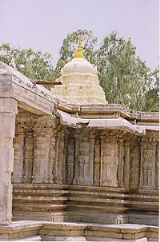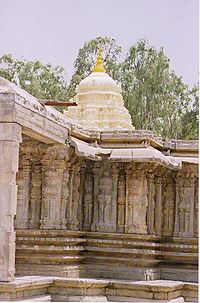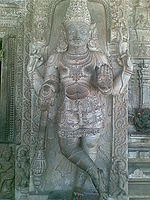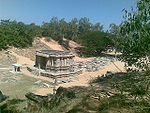
Talakad
Encyclopedia
Talakad is a desert-like town on the left bank of the Kaveri river
at a spot where the river makes a sharp bend. It is 45 km from Mysore and 133 km from Bangalore
in Karnataka
, India
. A historic site, Talakad once had over 30 temples that today are buried in sand. Now it is a scenic and spiritual pilgrimage
centre. Here the eastward flowing Kaveri river changes course and seems magnificently vast as here the sand on its banks spreads over a wide area.

The earliest authentic notice of the city of Talekād or Talakād, in Sanskrit Dalavana-pura, is in connection with the Ganga line of kings. Harivarma, who has been assigned to 247-266 A.D., was, according to an old chronicle, installed at Skandapura (said to be Gajalhatti, in the Coimbatore country, near where the Moyār flows into the Bhavāni), but resided in the great city of Dalavanapura in the Karnāta-dēsa. Thenceforward Talkād became the capital these powerful sovereigns and there the subsequent kings of that line were crowned.
At the beginning of the 11th century, the Gangas succumbed to the Chōlas, who captured Talkād and gave it the name of Rājarājapura. But about a hundred years later it was taken by the Hoysala king Vishnuvardhana, who drove the Chōlas out of Mysore. After this time we find that Talkād was composed of seven towns and five mathas or monastic establishments. The town of Māyilangi or Malingi, on the opposite side of the river, was also a large place, and had the name of Jananāthapura. Down to the middle of the 14th century, it remained a possession of the Hoysalas, and then passed into the hands of a feudatory of the Vijayanagar sovereigns, whose line appears to be known as that of Sōma-Rāja.
In 1634 it was conquered by the Mysore Rāja under the following circumstances. Tirumala-Rāja, sometimes called Srī Ranga Rāyal, the representative of the Vijayanagar family at Seringapatam (Srirangapatna), being afflicted with an incurable disease, came to Talkād for the purpose of offering sacrifices in the temple of Vedēsvara. His wife Rangamma was left in charge of the Government of Seringapatam ; but she, hearing that her husband was on the point of death, soon after left for Talkād with the object of seeing him before he died, handing over Seringapatam and its dependencies to Rāja Wodeyar of Mysore, whose dynasty ever afterwards retained them. It appears that Rāja Wodeyar had been desirous of possessing a costly nose-jewel which was the property of the Rāni, and being unable to obtain possession of it by stratagem, and eager to seize any pretext for acquiring fresh territory, he levied an army and proceeded against Talkād, which he took by escalade ; the Rāja of latter place falling in the action. The Rāni Rangamma thereupon went to the banks of the Cauvery, and throwing in the jewel, drowned herself opposite Mālingi, at the same time uttering a three-fold curse,-"Let Talakād become sand ; let Mālingi become a whirlpool ; let the Mysore Rājas fail to beget heirs." The latter part is now happily of no effect.
The following is what is known as the curse of Talkād, in the original :-
Talkādu Maralaāgi.
Mālingi maduvaāgi
Mysore dhorege makkalagade hōgali.
(ತಲಕಾಡು ಮರಳಾಗಿ; ಮಾಲಿಂಗಿ ಮಡುವಾಗಿ, ಮೈಸೂರು ದೊರೆಗೆ ಮಕ್ಕಳಾಗದೆ ಹೋಗಲಿ!)
The old city Talkād is completely buried beneath the hills of sand stretching for nearly a mile in length, only the tops of two pagodas being visible. The sand hills used to advance upon the town at the rate of 9 or 10 feet a year, principally during the south-west monsoon and as they pressed it close on three sides, the inhabitants were constantly forced to abandon their houses and retreat further inland. The town, however, is increasing in population, owing to the rich wet cultivation in the neighbourhood, derived from the Mādhavamantri anicut and channel. More than thirty temples, it is stated, are beneath the sand. That of Kírti Nārāyana is occasionally opened with great labour sufficiently to allow access for certain ceremonies. The most imposing temple left uncovered by the sand is that of Vaidyēsvara.
In the early part of the last century two temples Ānandēsvara and Gaurisankara, were unearthed. Four fragmentary records were found on the outer walls of the Pātālēsvara temple. One of these is an old inscription in Kannada of the Ganga period, the others being in Tamil. The Ānandēsvara temple is said to have been built by one Chidānandasvāmi, a contemporary of Haidar. A story is related of the Svāmi that he once crossed the Cauvery in full flood seated on a plantain leaf and that Haidar who witnessed the miracle greatly honoured him and made a grant of land for the temple founded by him. A Kannada inscription at the Gaurisankara temple tells us that this temple was built during the reign of the Mysore king Chikka-Dēva-Rāja-Wodeyar (1672-1704).
 The Hoysala ruler, Vishnuvardhana
The Hoysala ruler, Vishnuvardhana
, conquered the Gangas
and Talakad. He built the impressive Vijayanarayana Chennakesava Temple
at Belur.
, lie scattered about. Among the temples of Talakad, the Pathaleshwara, Maruleshwara, Arkeshwara, Vaidyanatheshwara and Mallikarjuna temples, the five Lingams believed to represent the five faces of Shiva, form the Pancha pathi
and have become famous. In honour of these five Shiva
temples, a fair is held once every 12 years called Panchalinga Darshana
, last held in 2009. The Panchalinga Darshana is held on a new moon day in the month of Karthika when two stars conjoin, the stars of Khuha Yoga and Vishaka.On this day, tradition has it that pilgrims should first bathe in the Gokarna theertham, worship Gokarneswara and Chandikadevi, and then worship Vaidyeshwara, and then bathe in the northern eastern southern and western stretches of the Kaveri and then worship Arkeshwara, Pataleshwara, Maraleshwara and Mallikarjuna, returning to Vaidyeshwara after each worship, finally worship Kirtinarayana and conclude the pilgrimage in one day.
 According to local legend, Ramanujacharya during his sojourn in Karnataka
According to local legend, Ramanujacharya during his sojourn in Karnataka
(also called Melnadu), established five Vishnu
temples of Lord Narayana
known as Pancha Narayana Kshetrams. Talakad is one of the Pancha Narayana Kshetrams where the Keerthi Narayana temple was established and the presiding Deity in this temple is Keerthi Narayana.
dynasty (erstwhile Maharajas) of Mysore.
The Talakad curse has established itself in the folklore as a miracle since the early part of 16th century because of two strange events visible even to date: (i) Talakad, an historically vibrant city, is now being submerged under sand dunes several meters deep, and (ii) the Mysore royal family have faced problem in having a rightful heir to the throne since the 17th century. Both these events linked to an apparent curse by a pious lady (Alamelamma) have defied logic. Based on the data from diverse sources and field studies, K. N. Ganeshaiah has reconstructed the possible chronology of events of this acclaimed miracle. Ganeshaiah argues that the Talakad phenomenon represents an ecological disaster unintentionally wrought on to a vibrant civilization at this place and in this sense the curse per se is an intelligently inserted story as an overlay. Using this example he discusses the possible process through which the miracles or myths of this kind survive in a society.http://www.ias.ac.in/currsci/dec102007/1495.pdf
The curse of Talakad - "Talakadu Maralagi, Malangi Maduvagi, Mysooru Arasarige Makkalagadirali"- the female Alamelamma cursed this way. (translation- ")May Talakadu be filled with Sand, Malangi be a Whirlpool and Mysore Kings shall not have offsprings")
The Talakadu shiva temples will be filled with sand and the same is excavated once in five by the Government and (the Local Temple Trust)and people are allowed to have darshan (called Panchalinga Darshan of Talakadu). Within one month of excavation and Panchalinga darshan, the sand will fill the temples like in a desert. Mysore Kings have all their offsprings by adoption since the day of Alamelamma's curse.
Two hunters Tala and Kada, are believed to have struck the tree with an axe to find blood gushing forth, and upon the bidding of a heavenly voice, dressed the wound of the tree with the tree's leaves and fruits. The tree healed, and the hunters became immortal. Since Shiva is believed to have healed himself through this incident, he is referred to as Vaidyeshwara. The Panchalingams here are all associated with this legend.
Kaveri River
The Kaveri , also spelled Cauvery in English, is a large Indian river. The origin of the river is traditionally placed at Talakaveri, Kodagu in the Western Ghats in Karnataka, flows generally south and east through Karnataka and Tamil Nadu and across the southern Deccan plateau through the...
at a spot where the river makes a sharp bend. It is 45 km from Mysore and 133 km from Bangalore
Bangalore
Bengaluru , formerly called Bengaluru is the capital of the Indian state of Karnataka. Bangalore is nicknamed the Garden City and was once called a pensioner's paradise. Located on the Deccan Plateau in the south-eastern part of Karnataka, Bangalore is India's third most populous city and...
in Karnataka
Karnataka
Karnataka , the land of the Kannadigas, is a state in South West India. It was created on 1 November 1956, with the passing of the States Reorganisation Act and this day is annually celebrated as Karnataka Rajyotsava...
, India
India
India , officially the Republic of India , is a country in South Asia. It is the seventh-largest country by geographical area, the second-most populous country with over 1.2 billion people, and the most populous democracy in the world...
. A historic site, Talakad once had over 30 temples that today are buried in sand. Now it is a scenic and spiritual pilgrimage
Pilgrimage
A pilgrimage is a journey or search of great moral or spiritual significance. Typically, it is a journey to a shrine or other location of importance to a person's beliefs and faith...
centre. Here the eastward flowing Kaveri river changes course and seems magnificently vast as here the sand on its banks spreads over a wide area.

History
The origin of the town in lost in antiquity; but one tradition is that its name was derived from two Kirāta twin brothers, Tala and Kādu, who, cutting down a tree which they saw wild elephants worshiping, discovered that it contained an image of Vishnu, and that the elephants were rishis transformed. The tree being miraculously restored, all obtained mōksha and the place was named Tala-kādu, which was translated into Sanskrit as Dala-vana. Two stone images declared to represent the brothers are pointed out in front of the temple Vaidyēsvara. In a later age, Rāma is said to have halted here on his expedition to Lanka.The earliest authentic notice of the city of Talekād or Talakād, in Sanskrit Dalavana-pura, is in connection with the Ganga line of kings. Harivarma, who has been assigned to 247-266 A.D., was, according to an old chronicle, installed at Skandapura (said to be Gajalhatti, in the Coimbatore country, near where the Moyār flows into the Bhavāni), but resided in the great city of Dalavanapura in the Karnāta-dēsa. Thenceforward Talkād became the capital these powerful sovereigns and there the subsequent kings of that line were crowned.
At the beginning of the 11th century, the Gangas succumbed to the Chōlas, who captured Talkād and gave it the name of Rājarājapura. But about a hundred years later it was taken by the Hoysala king Vishnuvardhana, who drove the Chōlas out of Mysore. After this time we find that Talkād was composed of seven towns and five mathas or monastic establishments. The town of Māyilangi or Malingi, on the opposite side of the river, was also a large place, and had the name of Jananāthapura. Down to the middle of the 14th century, it remained a possession of the Hoysalas, and then passed into the hands of a feudatory of the Vijayanagar sovereigns, whose line appears to be known as that of Sōma-Rāja.
In 1634 it was conquered by the Mysore Rāja under the following circumstances. Tirumala-Rāja, sometimes called Srī Ranga Rāyal, the representative of the Vijayanagar family at Seringapatam (Srirangapatna), being afflicted with an incurable disease, came to Talkād for the purpose of offering sacrifices in the temple of Vedēsvara. His wife Rangamma was left in charge of the Government of Seringapatam ; but she, hearing that her husband was on the point of death, soon after left for Talkād with the object of seeing him before he died, handing over Seringapatam and its dependencies to Rāja Wodeyar of Mysore, whose dynasty ever afterwards retained them. It appears that Rāja Wodeyar had been desirous of possessing a costly nose-jewel which was the property of the Rāni, and being unable to obtain possession of it by stratagem, and eager to seize any pretext for acquiring fresh territory, he levied an army and proceeded against Talkād, which he took by escalade ; the Rāja of latter place falling in the action. The Rāni Rangamma thereupon went to the banks of the Cauvery, and throwing in the jewel, drowned herself opposite Mālingi, at the same time uttering a three-fold curse,-"Let Talakād become sand ; let Mālingi become a whirlpool ; let the Mysore Rājas fail to beget heirs." The latter part is now happily of no effect.
The following is what is known as the curse of Talkād, in the original :-
Talkādu Maralaāgi.
Mālingi maduvaāgi
Mysore dhorege makkalagade hōgali.
(ತಲಕಾಡು ಮರಳಾಗಿ; ಮಾಲಿಂಗಿ ಮಡುವಾಗಿ, ಮೈಸೂರು ದೊರೆಗೆ ಮಕ್ಕಳಾಗದೆ ಹೋಗಲಿ!)
The old city Talkād is completely buried beneath the hills of sand stretching for nearly a mile in length, only the tops of two pagodas being visible. The sand hills used to advance upon the town at the rate of 9 or 10 feet a year, principally during the south-west monsoon and as they pressed it close on three sides, the inhabitants were constantly forced to abandon their houses and retreat further inland. The town, however, is increasing in population, owing to the rich wet cultivation in the neighbourhood, derived from the Mādhavamantri anicut and channel. More than thirty temples, it is stated, are beneath the sand. That of Kírti Nārāyana is occasionally opened with great labour sufficiently to allow access for certain ceremonies. The most imposing temple left uncovered by the sand is that of Vaidyēsvara.
In the early part of the last century two temples Ānandēsvara and Gaurisankara, were unearthed. Four fragmentary records were found on the outer walls of the Pātālēsvara temple. One of these is an old inscription in Kannada of the Ganga period, the others being in Tamil. The Ānandēsvara temple is said to have been built by one Chidānandasvāmi, a contemporary of Haidar. A story is related of the Svāmi that he once crossed the Cauvery in full flood seated on a plantain leaf and that Haidar who witnessed the miracle greatly honoured him and made a grant of land for the temple founded by him. A Kannada inscription at the Gaurisankara temple tells us that this temple was built during the reign of the Mysore king Chikka-Dēva-Rāja-Wodeyar (1672-1704).

Vishnuvardhana
Vishnuvardhana was an emperor of the Hoysala Empire in present day Indian state of Karnataka. Vishnuvardhana took the first step in consolidating the Hoysala Empire in South India through a series of battles against his overlords, the Western Chalukya empire...
, conquered the Gangas
Gangas
The Western Ganga Dynasty was an important ruling dynasty of ancient Karnataka in India. They are known as Western Gangas to distinguish them from the Eastern Gangas who in later centuries ruled over modern Orissa...
and Talakad. He built the impressive Vijayanarayana Chennakesava Temple
Chennakesava Temple
The Chennakesava Temple originally called Vijayanarayana Temple was built on the banks of the Yagachi River in Belur, an early capital of the Hoysala Empire. Belur is 40 km from Hassan city and 220 km from Bangalore, in Hassan district of Karnataka state, India. Chennakesava literally...
at Belur.
Temples
At Talakad sand covers the temples. Stone pillars, square at the base and made to fit into a wheel below the abacusAbacus (architecture)
In architecture, an abacus is a flat slab forming the uppermost member or division of the capital of a column, above the bell. Its chief function is to provide a large supporting surface to receive the weight of the arch or the architrave above...
, lie scattered about. Among the temples of Talakad, the Pathaleshwara, Maruleshwara, Arkeshwara, Vaidyanatheshwara and Mallikarjuna temples, the five Lingams believed to represent the five faces of Shiva, form the Pancha pathi
Pancha pathi
Pancha pathi are the five important pilgrim centers of Ayyavazhi. These are also considered as the primary Pathis and as worship centers of Ayyavazhi with primary status. The first pathi is Swamithope pathi itself and is the headquarters of Ayyavazhi...
and have become famous. In honour of these five Shiva
Shiva
Shiva is a major Hindu deity, and is the destroyer god or transformer among the Trimurti, the Hindu Trinity of the primary aspects of the divine. God Shiva is a yogi who has notice of everything that happens in the world and is the main aspect of life. Yet one with great power lives a life of a...
temples, a fair is held once every 12 years called Panchalinga Darshana
Panchalinga Darshana
Panchalinga Darshana is a holy festival held once every twelve years in the ancient temple town of Talakad on the banks of the Kaveri river in Karnataka, India....
, last held in 2009. The Panchalinga Darshana is held on a new moon day in the month of Karthika when two stars conjoin, the stars of Khuha Yoga and Vishaka.On this day, tradition has it that pilgrims should first bathe in the Gokarna theertham, worship Gokarneswara and Chandikadevi, and then worship Vaidyeshwara, and then bathe in the northern eastern southern and western stretches of the Kaveri and then worship Arkeshwara, Pataleshwara, Maraleshwara and Mallikarjuna, returning to Vaidyeshwara after each worship, finally worship Kirtinarayana and conclude the pilgrimage in one day.

Karnataka
Karnataka , the land of the Kannadigas, is a state in South West India. It was created on 1 November 1956, with the passing of the States Reorganisation Act and this day is annually celebrated as Karnataka Rajyotsava...
(also called Melnadu), established five Vishnu
Vishnu
Vishnu is the Supreme god in the Vaishnavite tradition of Hinduism. Smarta followers of Adi Shankara, among others, venerate Vishnu as one of the five primary forms of God....
temples of Lord Narayana
Narayana
Narayana or Narayan or Naraina is an important Sanskrit name for Vishnu, and in many contemporary vernaculars a common Indian name. Narayana is also identified as the original man, Purusha. The Puranas present divergent views on Narayana...
known as Pancha Narayana Kshetrams. Talakad is one of the Pancha Narayana Kshetrams where the Keerthi Narayana temple was established and the presiding Deity in this temple is Keerthi Narayana.
Curse of Talakad
Talakad is also tagged to the curse called “Curse of Talakad” by Alamelamma on the WodeyarWodeyar
The Wodeyar dynasty was an Indian royal dynasty that ruled the Kingdom of Mysore from 1399 to 1947, until the independence of India from British rule and the subsequent unification of the Indian dominion and princely states into the Republic of India.The spelling Wodeyar/Wadiyar is found in most...
dynasty (erstwhile Maharajas) of Mysore.
The Talakad curse has established itself in the folklore as a miracle since the early part of 16th century because of two strange events visible even to date: (i) Talakad, an historically vibrant city, is now being submerged under sand dunes several meters deep, and (ii) the Mysore royal family have faced problem in having a rightful heir to the throne since the 17th century. Both these events linked to an apparent curse by a pious lady (Alamelamma) have defied logic. Based on the data from diverse sources and field studies, K. N. Ganeshaiah has reconstructed the possible chronology of events of this acclaimed miracle. Ganeshaiah argues that the Talakad phenomenon represents an ecological disaster unintentionally wrought on to a vibrant civilization at this place and in this sense the curse per se is an intelligently inserted story as an overlay. Using this example he discusses the possible process through which the miracles or myths of this kind survive in a society.http://www.ias.ac.in/currsci/dec102007/1495.pdf
The curse of Talakad - "Talakadu Maralagi, Malangi Maduvagi, Mysooru Arasarige Makkalagadirali"- the female Alamelamma cursed this way. (translation- ")May Talakadu be filled with Sand, Malangi be a Whirlpool and Mysore Kings shall not have offsprings")
The Talakadu shiva temples will be filled with sand and the same is excavated once in five by the Government and (the Local Temple Trust)and people are allowed to have darshan (called Panchalinga Darshan of Talakadu). Within one month of excavation and Panchalinga darshan, the sand will fill the temples like in a desert. Mysore Kings have all their offsprings by adoption since the day of Alamelamma's curse.
Some other legends
Several other interesting legends also surround this shrine. It is believed that an ascetic Somadatta headed out to Siddharanya Kshetra Talakad to worship Shiva. Having been killed by wild elephants en route, he and his disciples re-incarnated as wild elephants and worshipped Shiva in the form of a tree at Talakad.Two hunters Tala and Kada, are believed to have struck the tree with an axe to find blood gushing forth, and upon the bidding of a heavenly voice, dressed the wound of the tree with the tree's leaves and fruits. The tree healed, and the hunters became immortal. Since Shiva is believed to have healed himself through this incident, he is referred to as Vaidyeshwara. The Panchalingams here are all associated with this legend.

